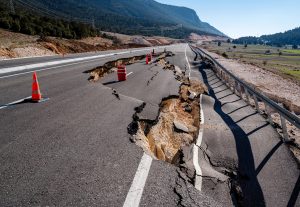New York City and New Jersey were jolted awake by a 4.8 magnitude earthquake, sending tremors of uncertainty across the East Coast. This seismic event, while relatively moderate in intensity, has sparked concerns and questions among residents. Understanding the implications, safety measures, through the aftermath of this earthquake.
Overview of the Earthquake
The recent earthquake registered a magnitude of 4.8 on the Richter scale, originating from a depth of 5.6 miles beneath the Earth’s surface. Its epicenter was pinpointed near the border between New York City and New Jersey, causing widespread shaking and alarm across the region.
Magnitude and Impact
The 4.8 magnitude quake may seem mild compared to historic seismic events, but its effects reverberated throughout densely populated urban areas. Buildings swayed, residents felt tremors, and concerns about structural integrity arose.

Duration and Aftershocks
The duration of the earthquake was brief but intense, lasting approximately 15 seconds. Subsequent aftershocks, though diminishing in strength, persisted for hours, fueling anxiety among residents.
Safety Measures and Preparedness
In the wake of the earthquake, prioritizing safety and preparedness is paramount to mitigate risks and ensure resilience in future seismic events.
Emergency Evacuation Procedures
Establishing clear evacuation routes and safe zones is crucial to swiftly and safely evacuate densely populated areas during earthquakes. Residents should familiarize themselves with designated evacuation points and emergency protocols.
Structural Assessments
Conducting thorough structural assessments of buildings and infrastructure is essential to identify vulnerabilities and reinforce safety measures. Engaging qualified engineers and inspectors can provide valuable insights into the integrity of buildings post-earthquake.
Community Resilience Initiatives
Promoting community resilience through education and outreach programs empowers residents to actively participate in disaster preparedness and response efforts. Collaborating with local authorities and organizations fosters a collective approach to resilience-building.
Impacts on Infrastructure and Utilities
The earthquake’s impact extended beyond structural damage, affecting essential infrastructure and utilities vital for urban functionality.
Transportation Disruptions
Temporary disruptions in public transportation systems, including subway services and road closures, were reported in the aftermath of the earthquake. Prompt restoration efforts and alternative transportation arrangements mitigated inconvenience for commuters.
Power Outages
Localized power outages were observed in areas directly affected by the earthquake, highlighting vulnerabilities in electrical infrastructure. Swift restoration measures were implemented to minimize disruptions and ensure uninterrupted power supply.
Water and Gas Supply
Precautionary measures were undertaken to assess and address potential disruptions to water and gas supply networks. Timely repairs and inspections safeguarded essential utilities, ensuring continued access for residents.
Environmental Implications
Understanding the environmental and geotechnical implications of the earthquake is crucial in assessing long-term impacts and implementing sustainable mitigation strategies.
Soil Liquefaction Risks
Areas with susceptible soil compositions face heightened risks of liquefaction during seismic events, compromising the stability of buildings and infrastructure. Conducting geotechnical assessments helps identify at-risk zones and implement mitigation measures.
Ecological Resilience
Assessing the ecological resilience of affected areas enables proactive conservation efforts and habitat restoration initiatives. Collaborating with environmental agencies and stakeholders fosters sustainable recovery and ecosystem preservation.
Public Safety and Awareness Campaigns
Raising public awareness and fostering a culture of safety are integral components of earthquake preparedness and resilience-building efforts.
Educational Outreach Programs
Engaging communities through educational outreach programs and workshops enhances awareness of earthquake risks and safety protocols. Empowering residents with knowledge enables informed decision-making during emergencies.
Media and Communication Strategies
Utilizing traditional and digital media platforms for disseminating timely updates and safety advisories ensures widespread outreach and accessibility. Leveraging social media channels fosters community engagement and facilitates real-time communication.

Q: What caused the recent earthquake in NYC and New Jersey?
A: The earthquake resulted from the release of accumulated stress along geological fault lines beneath the Earth’s surface, triggering seismic activity.
Q: Were there any casualties reported following the earthquake?
A: Fortunately, there were no reported casualties as a result of the earthquake. However, precautionary measures and safety protocols remain imperative.
Q: How can residents prepare for future earthquakes in the region?
A: Residents can prepare for future earthquakes by creating emergency kits, securing heavy furniture, and familiarizing themselves with evacuation procedures.
Q: Are aftershocks common after earthquakes?
A: Yes, aftershocks are common occurrences following earthquakes, though they typically diminish in intensity over time.
Q: What role do local authorities play in earthquake response efforts?
A: Local authorities play a crucial role in coordinating emergency response efforts, disseminating information, and ensuring public safety during earthquakes.
Q: How can individuals contribute to earthquake resilience efforts in their communities? A: Individuals can contribute to earthquake resilience efforts by participating in community preparedness initiatives, volunteering with local organizations, and staying informed about safety measures.
Conclusion:
Navigating through the aftermath of the 4.8 magnitude earthquake in NYC and New Jersey underscores the importance of resilience, preparedness, and community solidarity. By prioritizing safety measures, fostering public awareness, and implementing sustainable recovery strategies, we can strengthen our collective resilience and mitigate the impacts of future seismic events. As the situation continues to unfold, staying informed and prepared is key to navigating through the aftermath of the earthquake. By following safety guidelines, supporting one another, and staying updated on developments, we can collectively weather this event with resilience and solidarity.










